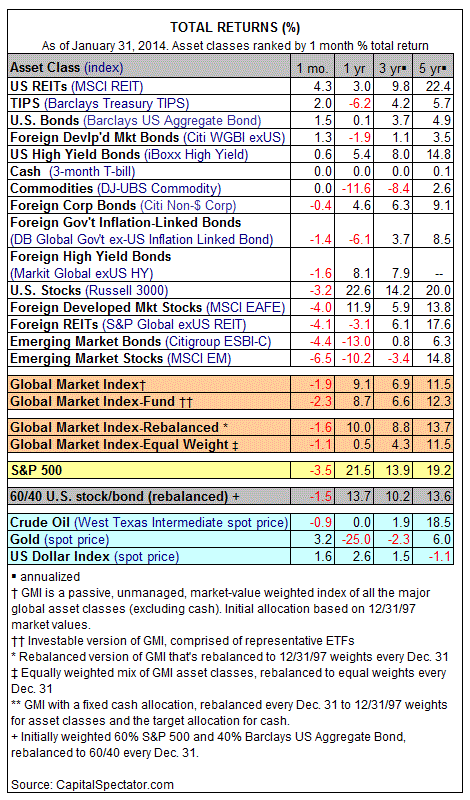Major Asset Classes | Jan 2014 | Performance Review
January was a rough month for many asset classes, stocks in particular. The weakest link: emerging markets, with equities in these countries retreating more than 6% last month, based on the MSCI Emerging Markets Index. The bias toward red ink weighed on the Global Market Index (GMI), which dropped 1.9%–the first monthly loss since last August. Despite the correction, GMI’s still comfortably in the black for the trailing one-year period, posting a 9.1% total return through last month, or moderately higher than the projected long-term performance for this passive benchmark of the major asset classes.
Despite the general weakness in prices, some asset classes posted handsome gains in the kick-off to 2014. Leading the way higher, US REITs enjoyed a 4.3% advance–the best calendar month for real estate securities since last April. January was also kind to TIPS, which advanced a robust 2.0%.
Quite a lot of ink has been spilled lately over the potential for trouble in emerging markets, including the risk of contagion throughout the global economy. Some pundits treat this risk as if it was something new. It isn’t, although there’s been a habit of dismissing the threat in recent years when these markets were dishing out impressive returns. At the end of 2012, for instance, stocks in emerging markets were the best performer that year, jumping more than 18%. Unsurprisingly, the crowd wasn’t worried about contagion at that point and instead emphasized the positive. The rationale in some circles was to focus on the case for seeing these nations as transformed, with reformed economies in terms of macro fundamentals. The bad old days had passed, replaced with a zeal for free-market policies.
Now the pendulum of perception is starting to swing in the opposite direction… again. The view that emerging markets had evolved into a more-stable set of economies was partly true, but it was oversold in 2010-2012; we’re probably going to see a general rush into the opposite extreme in the months (years?) ahead.
So it goes. Different asset classes fall in (and out) of favor, quite often at different times. Short of a rare case of systemic breakdown due to severe economic turmoil for the global economy a la 2008, we’re likely to see a mix of risk and return profiles across the major asset classes as a general rule. Par for the course.
The challenge is managing expectations in the short run as Mr. Market goes through another one of his periodic hissy fits. Does the change in the emotional weather come as a shock? It shouldn’t, just as the former run of unusually good performance numbers (as recently as last October, for instance) were destined for something closer to mediocrity. Until recently, GMI has been enjoying 10%-plus year-over-year performance. That’s always been unsustainable, and if the trailing returns fall far enough, the opposite analysis will apply. My long-run projection for GMI is in the 6%-7% range, but this too is subject to change. In fact, you can count on it, for a rather obvious reason: prices are constantly in flux.
Now’s a good time to reacquaint ourselves with the fundamental principle that expected returns are inversely related to trailing returns. Yes, we can do a lot of modeling if we’re intent on getting more granular with the numbers. But that’s a job for another day. Meantime, let’s recognize that the ebb and flow of expected returns is easily ignored when returns are materially above or below average. Such ignorance comes with a high price tag.
That’s one way of saying that reversion to the mean has a habit of persevering. Alas, there’s no guarantee, and this observation is worthless if your time horizon is a week from next Friday. There’s always a risk that buying low with the intention of selling high will suffer relative to its historical record, particularly in the short run. That’s the nature of attempting to earn a healthy risk premium through time. Free lunches are forever outlawed in this realm.
We can, of course, apply several risk-management techniques to defend our portfolios against uncertainty and boost the odds that we’ll reach our financial goals, starting with the building blocks of prudent money management: asset allocation and rebalancing. Anything’s possible as the future unfolds, but it takes a very dark outlook to assume that falling (rising) prices today will no longer be associated with higher (lower) expected returns tomorrow. An even bleaker worldview is required to imagine that most or all of the major asset classes will act materially different going forward relative to their histories for, say, rolling 3-year returns and risk. (Individual securities are another matter entirely, and one that we’ll sidestep here.)
Yes, the timing factor of when and how you rebalance is crucial. Unfortunately, perfection on this front will elude us. But here too we can diversify the risk by rebalancing through time, and in comparatively modest doses at any one point.
The bottom line: modest success is well within our grasp in matters of generating a reasonable risk premium. Yes, it could be different this time. But reviewing asset pricing across the centuries suggests otherwise. Fluctuating waves of optimism and pessimism are the norm, and our confidence for projecting more of the same is higher when consider multi-asset-class porfolios.
Perhaps the biggest risk in the money game is losing sight of this empirical fact–a risk that’s likely to be in the ascendancy for the foreseeable future.
Copyright © Capital Spectator
















